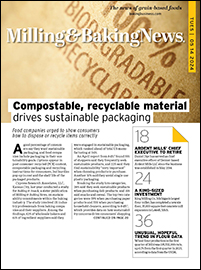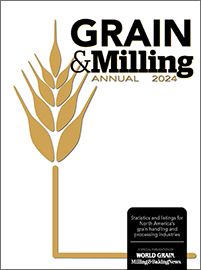Theories behind pre-hydration
Pre-hydrating flour and other dry minor ingredients has emerged recently as a means for controlling dough temperature in mixers. Not only does this process shorten overall mixing time, thus reducing the heat created during traditional mixing, it also potentially provides product quality benefits.
Although the concept of hydrating ingredients before mixing is well-established, the industry recently has taken several additional approaches to automating the process.
“Pre-hydration can be as straightforward as soaking ingredients in a tank,” Mr. Warren observed. “But what we are seeing in the industry now, however, are in-line hydrators that perform almost instantaneously and with little energy input compared with traditional mixing.”
Stephen Marquardt, sales director, food, for Zeppelin Systems USA, emphasized the difference between hydration and actual mixing. The first stage, or hydration of ingredients, involves blending, which cuts down on the time and energy needs of subsequent mixing and kneading stages.
“The high-speed mixing time will be reduced on average between 30 to 50%, depending on the required energy input for gluten structure development,” he said.
The current resurgence in the popularity of pre-hydration seems to date back to 2002, when Bernhard Noll, Ph.D., invented the Rapidojet. That patented system essentially shoots high-pressure water into a flowing stream of dry ingredients to hydrate them.
Fifteen years later, many bakers still are testing this and other types of technology to explore how pre-hydration may fit into their operations. They’re also verifying and validating how the technology may enhance loaf volume or provide more consistent incorporation of moisture within various types of baked goods.
Rapidojet uses its high-pressure liquid injection to create instant gluten development, said Ken Schwenger, president of Bakery Concepts International. That process, he added, reduces mix time by up to 65% while providing up to 8% higher yield with the same degree of “dough feel” and machinability, as well as other benefits.
“Dry ingredients and liquids are much more homogeneously bound,” he explained. “Thus, you have longer shelf life due to much slower starch retrogradation, the primary cause of staling. You also have faster fermentation because the high pressure adds approximately 30% more oxygen to the ingredient water.”
Because individual types of dry ingredients have different absorption rates, Mr. Schwenger said pre-hydration provides more homogenous mixing.
“Consider that flour has about 70% absorption, bran has 300% and vital wheat gluten has 400%,” he observed. “The results are imperfect products with limited shelf life because the most hydroscopic ingredients are never satisfied. Thus, they steal water from the product after baking. The patented use of high-pressure liquid injection via Rapidojet solves all of these problems. Every different ingredient can be instantly and fully hydrated prior to the final mix.”
Gluten, Mr. Schwenger noted, is developed instantly through the Rapidojet process, which is a mobile, stand-alone unit that can be moved to serve different mixers or multiple production lines.
“The final, legacy mixer is used just to homogenize minors and micros with the fully hydrated flour,” he explained. “The result is a mix time in the legacy mixer of only 5 minutes versus 12 to 15 minutes for a traditional mixing process.”
Meanwhile, Bühler’s JetMix system for pre-hydration of white and whole wheat flours creates a homogenous pre-dough that also reduces kneading time up to 30% in various tests, noted John Hunter, sales account manager, bakery and ingredient handling for Bühler.
The patented Bühler system features a 360-degree spray nozzle arrangement that aims to hydrate individual particles of flour.
“JetMix can be installed directly ahead of the mixer for both batch and continuous dough mixers,” Mr. Hunter said. “In addition, the JetMix can be integrated with holding tanks for both pre-hydration systems feeding multiple lines and pre-fermentation systems.”
Zeppelin System’s DymoMix, which is short for Dynamic Moistening Mixer, pre-hydrates multiple ingredients at the same time.
“Most of our clients prefer to pre-hydrate all dry ingredients including flour and also minor ingredients to eliminate the blending process in the mixer and provide a dust-free environment,” Mr. Marquardt said. “This also cuts the high-speed mixing time, which results in lower dough temperatures, creates an instantaneous biochemical process, increases the hydration of approximately 3 to 5%, and boosts line capacity by approximately one to 1.5 batches per hour.”
The continuous DymoMix uses centrifugal force to hydrate up to 8,800 lbs dry ingredients per hour with a hydration range of 10% to 150%.
“You can call it controlled mechanical pre-hydration,” Mr. Marquardt said. “We can add any water-soluble ingredients such cream yeast, sponges, sourdoughs, vinegar, high-fructose corn syrup, liquid sugars and more. You can also hydrate powdered sugar with oils or liquid butters, for example in applications such as for the confectionary industry.”
Mr. Warren confirmed the new hydrators can reduce the amount of energy and heat during the continuous mixing process by 30% or up to 50% in some batch mixing applications.
“Hydrator developers have used different principles to achieve their goal of instant, high-hydration levels,” he pointed out. “While these hydrators work differently, it is correct to say that the most recent designs are all focused on bringing liquids and dries together in a more efficient method to allow the dries to connect with the liquids more efficiently. This can be done multiple ways.”
Reading’s Exact Mixing Hydrobond technology uses a spray of fine droplets of water to hydrate a stream of individual dry particles, such as flour, prior to continuous mixing.
“We’re spraying in water in droplets, one piece at a time, making hydration as small as possible — piece by piece,” Mr. Warren said.
When used with a continuous mixer, Hydrobond speeds up the continuous process allowing the use of a smaller mixer to produce the same volume of finished dough as a larger system, which results in a smaller footprint, lower equipment investment and reduced energy costs. It also can be used with a pre-hydration system to mix particles of flour, minors and water directly into a brew holding tank.
Rapidojet provides two benefits when used to prepare “soaked” grains and seeds, said Dr. Noll.
“First, there is a very intense cleaning of the surface due to the high-pressure jet, which removes dirt but also mycotoxins,” he explained. “Second, the jet water hits the seeds with great impact that forces the water through small cracks of the surface of the seeds.”
In addition to promoting hydration, the process enhances sprouting of seeds for today’s trendy bread styles.







